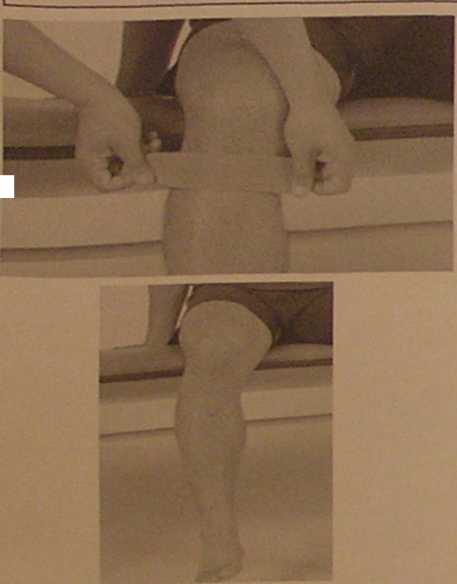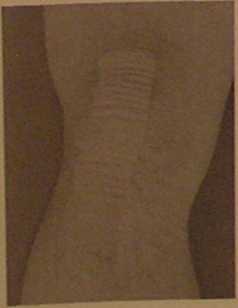P5140094
Osgoód-Schlatter and Larsen-Johannson Syndrome
Osgood-Schlatter syndrome is nn apophysitis of the patella ligament from lts insertion onto the tibinl tuberosity in an adblęscent patient. Larsen-Johańnson syndrome is an apophysitis to the patella liga-ment from its origin on the inferior pole of the patella. Both are chnracterizod by localized swclling, pain, and point tendemess of either the insertion or origin of the patella ligament.
There are several Kinesio taping techniques which may provide reduced inflammation and pain, the practitioner will need to determine which techniques is bost for their patient. If one technique does not provide significant results, another technique may.


Option One;
For acute pain relief a mechanical correction strip may be applied in an attempt to "hołd down" the apophysitis of the tibial tuberosity or inferior pole of the patella. If using this technique for Larsen-Johannson do not apply to much pressure as to alter patella tracking. For rcview see mechanical correction technique.
Place the patients' knee in slight flexion. Begin by tearing the paper backing of a 4 - 6 inch long Kinesio I strip in the middle. Holding both ends, apply a mechanical correction, modern te to severe, 50-75% of available tension with downward pressure to the center of the Kinesio strip over the tibial tuberosity or inferior pole of the patella.
Prior to laying down the Kinesio strip ends, have the patient move their knee into fuli extension and lay down the ends with no tension.
Option one may be applied first, and then a second Kinesio taping technique may be applied over the top. The patient may find the greatest decrease in pain during acute pain phases from a combination of taping techniąues. Then as the patients pain is reduced, only one tcchnique may be indicated.
Option Two;
Apply a patella tendonitis I strip. For complete review see patella tendonitis I strip technique.
Option Thrco:
Apply a patella tendonitis superior Y technique. For rcvicw see patella tendonitis.
Option Four:
Apply a patella tendonitis inferior Y technique. For review see patella tendonitis.
Option Five:
Apply a patella tendonitis superior and inferior Y technique. For review see patella tendonitis.
Option Six:
Apply a patella tendonitis U strip. For review see patella tendonitis.
143
Wyszukiwarka
Podobne podstrony:
P5140109 Sever s Syndrome or Apophysitis of the Calcaneus Scver s syndrome is an inflammation of the
DSC09966 Neurocutaneous syndromes Neurofibromatosis type I- tumors of the nerve and nerve sheats, me
and pitch is 8 mm. Height of the nut is 40 mm and coefficient of friction between screw and nut is 0
UHAM093 76 ^ UNDERSTANDING HEADACHES AND M I G RAI N ES A good starting point for any keen reader of
5 (1921) BIG 4 The Big 4 is world renowncd for reliability. It is buiit throughout of the finest mat
9 8 Figurę 9-8 Cross-fiber friction of the patellar tendon (A) and ligament (B) (Draping option 4)
and pitch is 8 mm. Heiglit of the nut is 40 mm and cocfficicnt of friction between screw and nut is
198 Zbigniew RACZYŃSKI (17,690 kg) and axle load (5,900 kg) are not exceeded by any of the units. Pa
P5140072 Osteoarthritis of the Hip Osteoafthritis of tłu• hip is dcgnerativc dcstruction of the arti
P5140073 Trochanteric Bursitis Trdchanteric bursitis is a common condidon of the hip which results i
P5140120 Plantar Fasciitis Plantar Fasciitis is an inflammation of the plantar aponeurosis. Pain and
P5140121 Plantar Fasciitis Plantnr Fnsditis is on inflammation of the plantar aponeurosis. Pain and
3 New Series No. 96 and control are concerned, is simply a delegation of the Government in London --
P5140039 Thoradc Outlet Syndrome I Thoradc outlet syndrome is a compression of the
P5140042 w With the arm still in an abducted D niiddle of the paper backing of an ar?‘^ te. ine
P5140043 Costochondral Separation or Sprain A separation or sprain to the juncfion of the castocarłi
P5140055 1Medial and Literał Epicondylitis Combination Taping The practitioner may desire to use a c
P5140057 Medial Epicondylitis of the Elbow Medial epicondylitis results from repetitive forceful f!e
P5140061 T r the paper backing of the Kinesio I stip in the ‘ M the button holes and apply over eith
więcej podobnych podstron